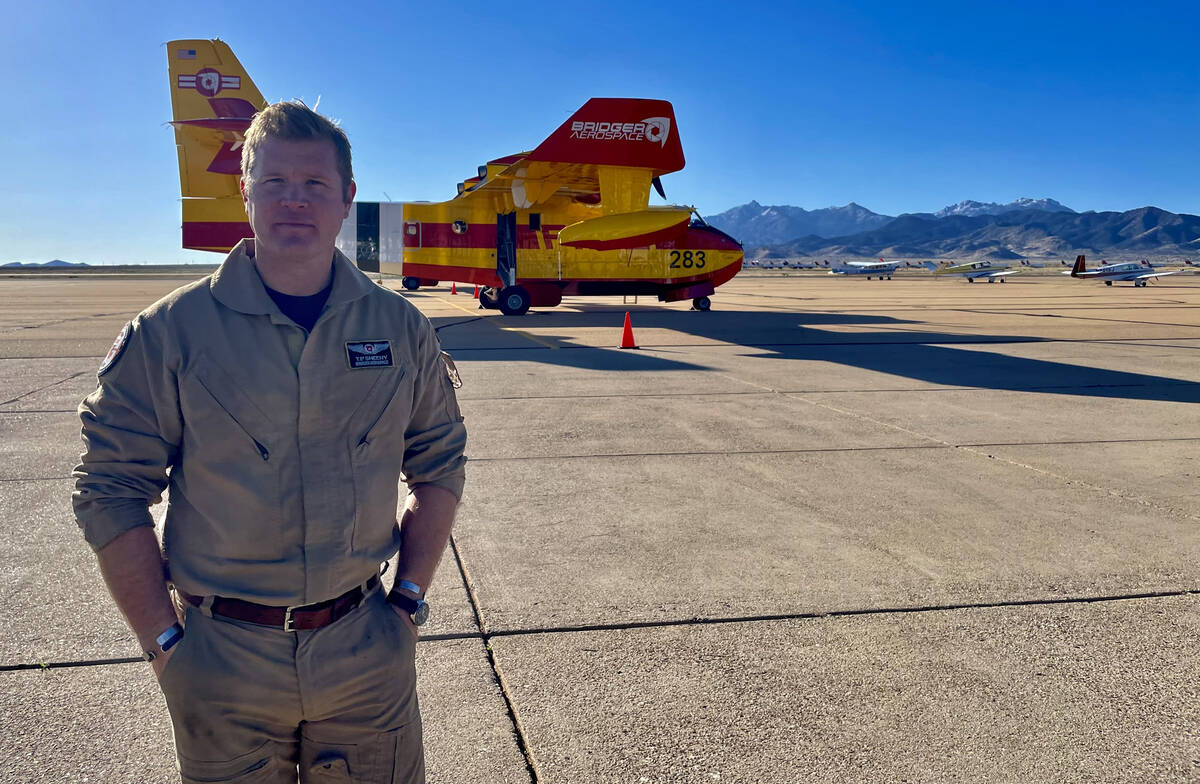
It’s Fire Physics 101: Fire needs three things to sustain itself —heat, fuel and oxygen. Take away any one of those three and the fire will die.
Fire fighting is really a series of possible actions aimed at starving the fire of one of the things it needs to live. Water takes away heat. Retardants, which can be chemical or something as simple as sand, choke off oxygen. An open area devoid of anything flammable starves a fire of fuel. But in non-urban settings, achieving any of those things gets complicated.
Standing in front of a pair of C-215 “Super Scooper” planes at the airfield in Kingman, Arizona, on Friday morning, Mike Theune of the National Park Service explains, “Fire lines are an effective way of controlling wildfires, but creating them takes time and people. Getting water on the fire as quickly as possible is our best option for keeping fires away from people and structures. And these planes are a great way of getting that done.”
The C-215s are owned by Bridger Aerospace based in Bozeman, Montana, but, according to Bridger CEO (and pilot) Tim Sheehy, they service the entire lower 48 states. “We do a lot of work in the western U.S., but we have provided our services for wildfires as far away as Florida,” he said.
The planes and the Bridger team were camped out at an aircraft maintenance company called Air-Zona at the Kingman Airport for some pre-fire-season practice. They spent the morning scooping up water from Lake Mojave and then dumping it back into the lake.
The C-215s looks something like a cross between a boat and a propeller-driven airplane, which is appropriate because that is exactly what they are.
“When we are on the water, it is basically a boat. But it is a boat that is going 100 miles per hour and taking on water rapidly,” Sheehy explained.
Theune provided some details. “The Super Scoopers can take up almost 1,500 gallons of water in about 10 seconds,” he said. “That volume of water may not extinguish a fire, but it provides quick ‘oomph’ and real help for crews working on the ground.”
As an example, Theune points to the blaze at Bonelli Peak in 2019. Sandwiched between the Overton Arm of Lake Mead and Echo Bay, the area is remote yet still popular with hikers, many of whom say it offers the best view of any peak in Southern Nevada. “Because we had access to a Super Scooper, we had water on that fire in 22 minutes. By way of comparison, it takes more like 90 minutes to get a ground crew in place.”
These planes have been a fixture in firefighting efforts in the Southwest for many years. Bridger Aerospace, which has been around since 2014, operates 23 of them. “A two-plane team like this can go up to four or five hours before they have to refuel. We can do two fueling cycles per plane in a day,” Sheehy explained. “That means that, depending on how far it is from the water to the fire, we can do as many as 100 water drops in a day.”
Theune adds that 93 percent of fires in the U.S. occur in a place within 20 miles of a body of water.
While they are effective, operating a fleet of C-215s is not without modern challenges. “There is a serious pilot shortage just in general in the U.S. if not worldwide,” Sheehy said. “And our pilots are not just people qualified to fly commercial aircraft. They need experience flying at low altitudes in mountainous environments and they need seaplane experience,” he said. “Most of our pilots come to us from services in the Alaska bush or from Canada and most have military backgrounds.”
He noted that one advantage they have with finding pilots just comes down a basic approach on life. “The kinds of pilots who want to do this kind of work are generally not people who would be happy just flying a route on a commercial airliner. So we’re not too worried about losing them to these guys,” he said, gesturing at a fleet of name-brand regional jets parked at the Kingman airport near the C-215s.
Another challenge is more about technology and the modern drive to post everything online.
“Drones,” says Theune. “I often tell drone operators that, ‘If you fly, we can’t.’” He noted that there have been times when firefighting aircraft have had had to pull back from fighting an active fire because of private drones in the air trying to take their own video of the fire.
“If a plane like this were to collide with a drone,” he said, his voice trailing off. “The drone may not be large, but it can cause significant damage.”
Contact reporter Bill Evans at wevans@bouldercityreview.com or at 702-586-9401.